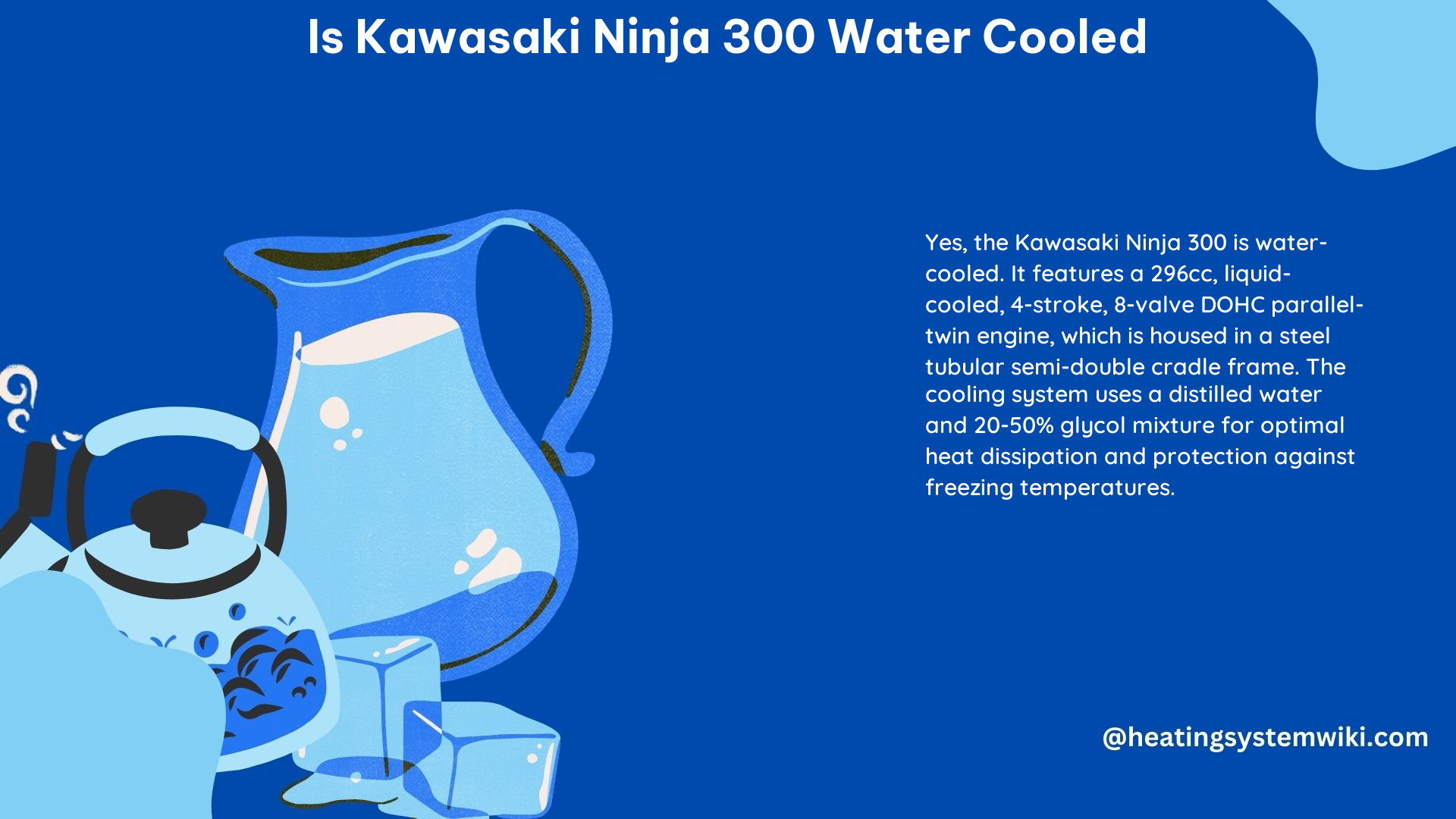The Kawasaki Ninja 300 is a popular entry-level sportbike that has gained a reputation for its impressive performance and handling characteristics. One of the key features of this motorcycle is its liquid-cooled engine, which plays a crucial role in maintaining optimal operating temperatures and ensuring consistent power delivery. In this comprehensive guide, we will delve into the details of the Ninja 300’s water-cooled system, its maintenance requirements, and the technical specifications that make this bike a standout in its class.
Understanding the Ninja 300’s Liquid-Cooled Engine
The Kawasaki Ninja 300 is powered by a 296 cc (18.1 cu in) liquid-cooled, 4-stroke, 8-valve, DOHC parallel-twin engine. This engine configuration, with a bore and stroke of 62 mm × 49 mm (2.4 in × 1.9 in) and a compression ratio of 10.6:1, is designed to deliver a balance of power and efficiency.
The liquid-cooling system plays a vital role in maintaining the engine’s optimal operating temperature, which is essential for consistent performance and longevity. The system utilizes a water pump to circulate a 50/50 mixture of distilled water and antifreeze through the engine block, cylinder heads, and a radiator. This mixture helps to dissipate heat efficiently, preventing the engine from overheating and ensuring consistent power delivery.
Maintaining the Cooling System

Proper maintenance of the Ninja 300’s cooling system is crucial to ensure its long-term reliability and performance. Here are some key points to consider:
-
Coolant Mixture: As mentioned earlier, the recommended coolant mixture is a 50/50 blend of distilled water and antifreeze. This ratio provides adequate freeze protection and helps prevent corrosion within the cooling system.
-
Coolant Replacement: Kawasaki recommends replacing the coolant every two years or 12,000 miles (19,000 km), whichever comes first. This helps to maintain the integrity of the coolant and prevent the buildup of contaminants that can compromise the system’s efficiency.
-
Radiator Inspection: Regularly inspect the radiator for any signs of damage, such as bent fins or leaks. Ensure that the radiator is free from debris and that the cooling fan is functioning correctly.
-
Hose Condition: Check the condition of the coolant hoses for any cracks, brittleness, or signs of deterioration. Replace any damaged hoses to prevent leaks and ensure proper coolant circulation.
-
Thermostat Functionality: The thermostat plays a crucial role in regulating the engine’s operating temperature. Ensure that the thermostat is opening and closing correctly, as a malfunctioning thermostat can lead to overheating or poor temperature regulation.
-
Coolant Leaks: Regularly inspect the entire cooling system for any signs of leaks, as even small leaks can lead to a loss of coolant and potential engine damage.
Technical Specifications and Performance
The Kawasaki Ninja 300’s liquid-cooled engine delivers impressive performance for an entry-level sportbike. Some of the key technical specifications include:
- Engine Displacement: 296 cc (18.1 cu in)
- Engine Type: Liquid-cooled, 4-stroke, 8-valve, DOHC parallel-twin
- Bore x Stroke: 62 mm × 49 mm (2.4 in × 1.9 in)
- Compression Ratio: 10.6:1
- Maximum Power Output: 29 kW (39 hp) @ 11,000 rpm
- Maximum Torque: 23.66 N⋅m (17.45 lb⋅ft) @ 9,750 rpm
- Top Speed: 171 to 192 km/h (106 to 119 mph)
The Ninja 300’s liquid-cooled engine, combined with its lightweight chassis and responsive handling, makes it a popular choice for both new and experienced riders. The bike’s 6-speed transmission and slipper clutch further enhance the riding experience, providing smooth and controlled power delivery.
DIY Maintenance and Resources
For riders interested in performing their own maintenance on the Kawasaki Ninja 300, there are numerous online resources available, such as the Kawasaki Ninja 300 Forums. These forums provide a wealth of information on various aspects of the bike, including maintenance tips, performance upgrades, and troubleshooting advice.
By understanding the Ninja 300’s liquid-cooled engine, its maintenance requirements, and the technical specifications that make it a standout in its class, riders can ensure their bike’s optimal performance and longevity. Whether you’re a new or experienced rider, this comprehensive guide will help you navigate the world of the Kawasaki Ninja 300 and make the most of your riding experience.
